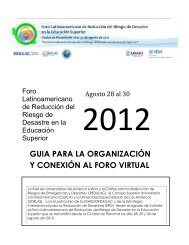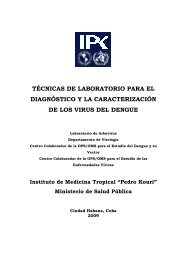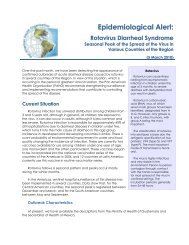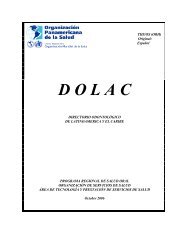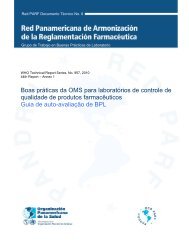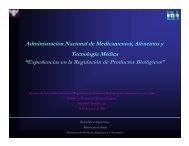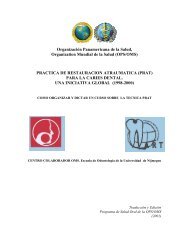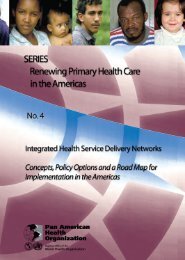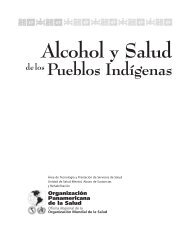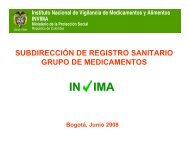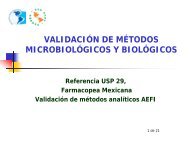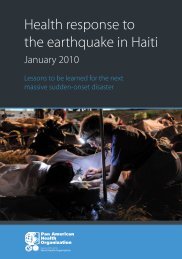Strategy and Plan of Action on Epilepsy - PAHO/WHO
Strategy and Plan of Action on Epilepsy - PAHO/WHO
Strategy and Plan of Action on Epilepsy - PAHO/WHO
You also want an ePaper? Increase the reach of your titles
YUMPU automatically turns print PDFs into web optimized ePapers that Google loves.
Nati<strong>on</strong>al activities<br />
51. st Directing Council / 63 .rd Sessi<strong>on</strong> <str<strong>on</strong>g>of</str<strong>on</strong>g> the Regi<strong>on</strong>al Committee<br />
1.3.2 Review the cost <str<strong>on</strong>g>and</str<strong>on</strong>g> financing <str<strong>on</strong>g>of</str<strong>on</strong>g> the epilepsy program <str<strong>on</strong>g>and</str<strong>on</strong>g> respective services, as well as the structure <str<strong>on</strong>g>of</str<strong>on</strong>g> the<br />
expenditure, defining short-, medium-, <str<strong>on</strong>g>and</str<strong>on</strong>g> l<strong>on</strong>g term goals for funding service delivery, with emphasis <strong>on</strong><br />
primary care.<br />
1.3.3 Identify potential sources <str<strong>on</strong>g>of</str<strong>on</strong>g> financing <str<strong>on</strong>g>and</str<strong>on</strong>g> d<strong>on</strong>ors <str<strong>on</strong>g>and</str<strong>on</strong>g> request funding.<br />
Objective 1.4: Create <str<strong>on</strong>g>and</str<strong>on</strong>g> strengthen health sector partnerships with other key sectors <str<strong>on</strong>g>and</str<strong>on</strong>g><br />
actors, including the private sector.<br />
Regi<strong>on</strong>al activities<br />
1.4.1 Cooperate with the countries to strengthen the formati<strong>on</strong> <str<strong>on</strong>g>of</str<strong>on</strong>g> nati<strong>on</strong>al networks.<br />
1.4.2 Support associati<strong>on</strong>s <str<strong>on</strong>g>of</str<strong>on</strong>g> people with epilepsy <str<strong>on</strong>g>and</str<strong>on</strong>g> their families, facilitating informati<strong>on</strong>-sharing am<strong>on</strong>g<br />
countries <str<strong>on</strong>g>and</str<strong>on</strong>g> disseminati<strong>on</strong> <str<strong>on</strong>g>of</str<strong>on</strong>g> the less<strong>on</strong>s learned.<br />
1.4.3 Strengthen partnerships with internati<strong>on</strong>al instituti<strong>on</strong>s <str<strong>on</strong>g>and</str<strong>on</strong>g> other regi<strong>on</strong>al partners.<br />
Nati<strong>on</strong>al activities<br />
1.4.4 Create an intersectoral coordinating body.<br />
1.4.5 Promote social participati<strong>on</strong> as part <str<strong>on</strong>g>of</str<strong>on</strong>g> the formulati<strong>on</strong>, executi<strong>on</strong>, <str<strong>on</strong>g>and</str<strong>on</strong>g> evaluati<strong>on</strong> <str<strong>on</strong>g>of</str<strong>on</strong>g> the epilepsy program.<br />
1.4.6 Provide public sector support for organizati<strong>on</strong>s <str<strong>on</strong>g>of</str<strong>on</strong>g> users <str<strong>on</strong>g>and</str<strong>on</strong>g> families <str<strong>on</strong>g>and</str<strong>on</strong>g> actively involve them in epilepsy programs.<br />
Strategic Area 2: Health services network for the treatment <str<strong>on</strong>g>of</str<strong>on</strong>g> people with epilepsy,<br />
with emphasis <strong>on</strong> primary health care <str<strong>on</strong>g>and</str<strong>on</strong>g> the provisi<strong>on</strong> <str<strong>on</strong>g>of</str<strong>on</strong>g> drugs.<br />
Indicators<br />
• Regi<strong>on</strong>al epilepsy mortality rate (per 100,000 populati<strong>on</strong>). (Baseline in 2010: 0.8. Target:< 0.8.)<br />
• Percentage <str<strong>on</strong>g>of</str<strong>on</strong>g> people with epilepsy who are not treated. (Baseline in 2009: an estimated 60%. Target: 30% by 2020.)<br />
• Preparati<strong>on</strong> <str<strong>on</strong>g>and</str<strong>on</strong>g> publicati<strong>on</strong> <str<strong>on</strong>g>of</str<strong>on</strong>g> a regi<strong>on</strong>al epilepsy training module (guides), based <strong>on</strong> the competencies required<br />
to meet the needs, targeting primary care workers. 5 (Baseline in 2010: 1 (mhGAP-IG). Target: 1 adapted to the<br />
regi<strong>on</strong>al level by 2013 <str<strong>on</strong>g>and</str<strong>on</strong>g> 1 revised by 2020.)<br />
Objective 2.1: Provide a package <str<strong>on</strong>g>of</str<strong>on</strong>g> essential interventi<strong>on</strong>s for people with epilepsy in primary<br />
health care, ensuring access to basic medicati<strong>on</strong>s <str<strong>on</strong>g>and</str<strong>on</strong>g> educati<strong>on</strong> for self management.<br />
Regi<strong>on</strong>al activities<br />
2.1.1 Collaborate with the countries in organizing the delivery <str<strong>on</strong>g>of</str<strong>on</strong>g> service to people with epilepsy, with emphasis<br />
<strong>on</strong> boosting the resp<strong>on</strong>se capacity in primary health care.<br />
5 The mhGAP Interventi<strong>on</strong> Guide for mental, neurological, <str<strong>on</strong>g>and</str<strong>on</strong>g> substance use disorders in n<strong>on</strong>-specialized health settings (mh-<br />
GAP-IG) is a global tool that is currently available but will need to be adapted to the regi<strong>on</strong>al level.<br />
7




